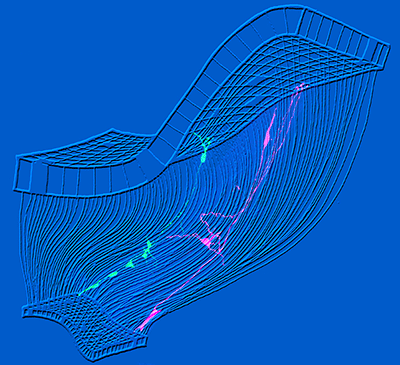Autism may arise from a genetic defect during ‘scaffolding’ of the developing brain, according to new research.
The discovery highlights the molecular details of a key process in brain development. It also adds to the scientific understanding of the biological basis of autism.

In green, a normal radial glial cell and its neuronal progeny superimposed in a cortex scaffold illustration. In purple, a Memo1-deficient cell and progeny. MEMO1 mutations are associated with autism and epilepsy
Eva S Anton, PhD, is a senior author of the study. He is a professor of cell biology and physiology at the UNC School of Medicine in North Carolina and a member of the UNC Neuroscience Center.
‘ASD caused very early on’
Anton said: “This finding suggests that ASD can be caused by disruptions occurring very early on, when the cerebral cortex is just beginning to construct itself.”
The cerebral cortex – which in humans is responsible for higher brain functions including perception, speech, long-term memory, and consciousness – is relatively large and dominant compared to other brain structures.
There is nowhere near a full understanding of how the cortex constructs itself in the developing brain of humans or other mammals.
But scientists know that early in cortical development, precursor cells called radial glial cells (RGCs) appear at the bottom of the developing cortex in a regularly spaced or tiled pattern.
Scaffolding system
Each RGC sprouts a single stalk-like structure, called a basal process, that extends to the top of the cortex. Collectively, these RGCs and their basal processes form a scaffold, much like the scaffolding of a construction site.
RGCs divide to form young cortical neurons. These baby neurons climb the scaffold to find their proper places in the developing brain.
The cortex, thanks to this scaffolding system, normally develops a highly regular structure. It consists of six distinct layers of neurons in the normal formation of functional neural cortical circuits.
Genetic encoding needed
Anton and his colleagues discovered that a gene encoding for a protein called Memo1 is needed to organize the tiled radial glial cell scaffold. Mutations in the Memo1 gene have also been found in some people with autism and are suspected of causing the condition.
To explore Memo1’s role in brain development and autism, Anton’s team engineered mice to delete the Memo1 gene in RGCs early in brain development.
They found the resulting RGC scaffold was disrupted. Each RGC’s stalk-like basal process formed too many branches and no longer formed a guiding scaffold. The result was neuronal misplacement and disorganized layers.
The scientists traced this ill effect, in part, to unstable microtubules. These tiny tubules normally help reinforce the scaffold structure and serve as railways for the internal traffic of key molecules necessary for RGC function.
Supporting the autism connection
Intriguingly for the researchers, studies of the brains of children with autism found patches of similar neuronal disorganization. They analyzed MEMO1 genetic mutations reported recently in individuals with autism behaviours and intellectual disabilities. They discovered the human MEMO1 genetic mutation resulted in a shortened form of the Memo1 protein and this could disrupt RGC development
Further supporting the autism connection, Anton and his colleagues discovered the mice lacking Memo1 in their RGCs behaved abnormally. The mice displayed a lack of explorative activity, similar to that seen in some people with autism.
The findings overall suggest that Memo1-associated autism may be wired into the brain very early in development in comparison to other forms of autism. Its origins may be in disrupted neuronal differentiation and connectivity.
Foundational knowledge
“For disorders of brain development such as ASD, it is important to understand the origins of the problem even if we are still far away from being able to correct developmental disruptions occurring in utero,” Anton said.
“We need this foundational knowledge if we are to truly get to the root causes of these conditions and eventually develop better diagnostic or therapeutic strategies.”
Anton and colleagues are continuing to evaluate MEMO1 in cortical development and autism.
As more human mutations are identified in this gene family and other ASD genes, they plan to shift from experiments in mice to the study of human brain organoids. These are a kind of mini-brain that can be grown from patient-derived stem cells with ASD-related mutations.
The researchers published their study in Neuron.
The co-authors were Naoki Nakagawa PhD, Charlotte Plestant PhD, Keiko Yabuno-Nakagawa PhD, Jingjun Li PhD, Jason L. Stein PhD, all of UNC-Chapel Hill; Zoltan Molnar of the University of Oxford, and Ali Badache PhD, of Centre de Recherche en Cancérologie de Marseille.
Related:
- Gene mutation find points to treatments
- Network of 200 genes linked to autism
- 18 new genes found with links to autism
- Risk linked to common genes
- Gene found linking seizures and autism
- Cancer drug may reverse genetic autism
- Gene find points to better treatment
- New test heralds early autism diagnosis
- Gene link found to autistic behaviours
- Links found to bipolar and schizophrenia
Published: 2 July 2019
















